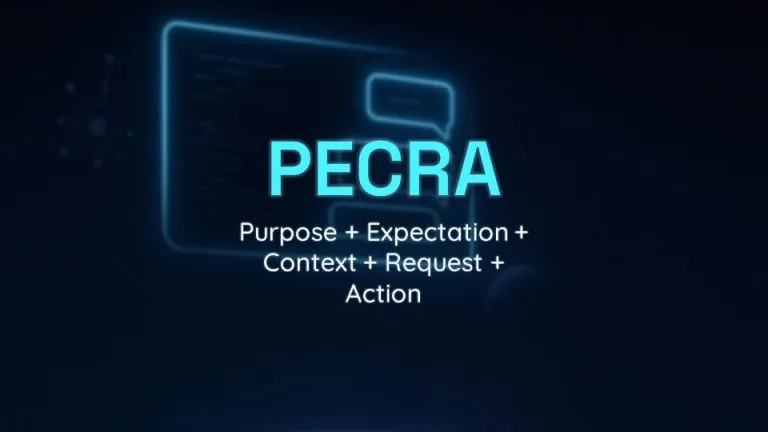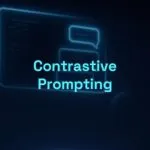PECRA Framework: Purpose, Expectation, Context, Request, Action

In a sea of AI interactions, it’s not always easy to get responses that truly meet our needs. Sometimes clarity is missing, other times context… That’s where the PECRA framework comes in — a powerful structure that helps you craft complete, precise prompts aligned with your intentions.
By including elements like Purpose and Expectation, PECRA doesn’t just guide what the AI should do, but also why and how it should do it. This reduces ambiguity, improves response relevance, and helps you get more accurate results — even for complex tasks.
If you need deeper responses or are developing content, plans, diagnostics, or detailed guidance with LLMs like ChatGPT, Claude, or Gemini, this structure will elevate your communication with AI.
Let’s explore how PECRA works, when to use it, and how to apply it with practical examples and personalization tips.
What is the PECRA Framework?
PECRA is a structured framework that allows you to create more complete and effective prompts — especially useful when you need to convey specific intentions to the AI. It combines clear purpose, explicit expectations, relevant context, objective request, and well-directed action.
This combination ensures that models like ChatGPT, Claude, or Gemini understand not just what you want, but also why you want it, in what setting, and how to present the response. It minimizes communication gaps and increases the chances of getting results that match what you really need.
Structure Components
- Purpose: Why are you making this request? What is the ultimate goal of the interaction?
- Expectation: What kind of response do you expect from the AI? A plan? A list? A diagnosis? A detailed piece of content?
- Context: What background information does the AI need to fully understand your request?
- Request: What exactly do you want the AI to do? This is the core of your prompt.
- Action: How should this task be carried out or presented? This may include topic order, priority, language, etc.
These five elements form a clear, strategic, and highly customizable prompt — ideal for interactions where details matter.
When to Use It?
The PECRA framework is especially useful when:
- You want to ensure the response aligns with a clear goal.
- You need more elaborate, structured, or analytical content.
- You’re preparing prompts for complex or multi-layered tasks.
- You want results that resemble a professional briefing.
💡 Use PECRA when you want the AI to deeply understand your request and deliver something ready to apply or publish.
Typical structure example:
“With the goal of X (Purpose), I expect a response that is Y (Expectation), considering that Z (Context). Therefore, I ask you to do W (Request) and organize/execute it as follows: Q (Action).”
Practical Examples of PECRA in Action
To understand how the PECRA framework works in practice, there’s nothing better than seeing full prompts in different contexts. Below are three examples showing how this structure can guide the AI with clarity and depth — each designed to solve a real problem with precision and focus.
Example 1: Instagram Content Planning
Context: You’re a social media manager and need a posting plan to promote a new line of sustainable cosmetic products.
With the goal of promoting a new line of sustainable cosmetics on Instagram (Purpose), I expect a response with creative post ideas aligned with the brand’s identity (Expectation), considering that the target audience is mostly women aged 25–40 interested in natural beauty and sustainability (Context). Therefore, I ask you to suggest a calendar with 5 post ideas for a week-long campaign (Request) and organize the response in a table with date, post type, description, and call-to-action (Action).Why it works: The PECRA formula is complete: there’s a clear goal, a defined expectation, detailed context, a specific request, and a usable format.
Example 2: Diagnosing Remote Team Issues
Context: You’re an HR manager trying to understand the main causes of low productivity in a remote team.
With the goal of diagnosing the main factors affecting productivity in a remote team (Purpose), I expect a response with detailed analysis and suggested approaches (Expectation), considering that the team is spread across time zones and facing communication and motivation issues (Context). Therefore, I ask you to identify 3 likely causes (Request) and organize the response into bullet points with clear explanations and practical improvement suggestions (Action).Why it works: The prompt guides the AI to think analytically, taking into account the specific scenario and delivering an actionable response.
Example 3: Script for Educational Video
Context: You’re producing a short YouTube video explaining the concept of “overfitting” in machine learning.
With the goal of creating an educational and accessible video on the concept of overfitting (Purpose), I expect a response that provides a brief script using simple language and easy-to-understand analogies (Expectation), considering that the target audience is beginner data science students (Context). Therefore, I ask you to create a script with an introduction, explanation with example, analogy, and conclusion (Request), and deliver the content in bullet points with estimated time for each part (Action).Why it works: This prompt clearly defines the tone, audience, format, and expected structure — all crucial for video content.
Tips to Make the Most of PECRA
The PECRA framework is naturally robust, but a few simple tweaks can help you adapt it to your exact needs. Personalizing each component lets you refine the tone, depth, and style of the AI’s response. Here are some practical tips to get the best out of this structure.
Customize for Your Goal
Each PECRA element can be shaped to reflect your specific purpose. Here’s how to tailor each part for even more aligned results:
- Purpose: Define a goal that’s clear and motivating. For example, “inspire my team” sets a different tone than “optimize processes.” The more specific, the better the AI captures the intent.
- Expectation: Be explicit about the desired output. Want something creative? Ask for “innovative ideas.” Need analysis? Say “detailed diagnosis.” This avoids generic responses.
- Context: Adapt the scenario to your audience or situation. “My team is small and new” requires a different approach than “a global company in crisis.” Details change everything.
- Request: Refine the task to avoid ambiguity. “List ideas” is vague; “suggest 3 practical strategies” is direct and actionable.
- Action: Choose the format and style strategically. A table organizes data, while bullet points with examples make explanations easier to digest. Think about the final use of the response.
Quick example:
“With the goal of engaging my audience on LinkedIn (Purpose), I expect creative post ideas (Expectation), considering I’m a career coach for young professionals (Context). Suggest 3 post topics (Request) in short bullets with catchy hooks (Action).”
These personalizations turn PECRA into a flexible tool — ready to support anything from simple tasks to complex projects.
Start Using PECRA Today
With the PECRA – Purpose, Expectation, Context, Request, Action framework, you have a powerful structure for creating highly aligned prompts. Whether generating ideas, structuring content, conducting analysis, or planning, PECRA ensures the AI deeply understands your needs — and delivers more effective responses from the very first prompt.
🎯 Quick Summary:
PECRA guides the AI based on why you’re asking (Purpose), what you expect to receive (Expectation), in what scenario it applies (Context), what the task is (Request), and how the response should be delivered (Action).
All of this forms a complete, clear prompt ready to generate results.
🔗 Want to explore more frameworks like this?
Check out the Practical Guide to Prompt Techniques, Frameworks, and Formulas for LLMs, with dozens of detailed and applicable structures for different contexts and goals, plus techniques and prompt engineering tips.
📘 Bonus tip:
Download the free eBook “Prompt Engineering Unveiled”, featuring easy explanations, practical examples, and strategies ranging from basic to advanced to master communication with AI.



